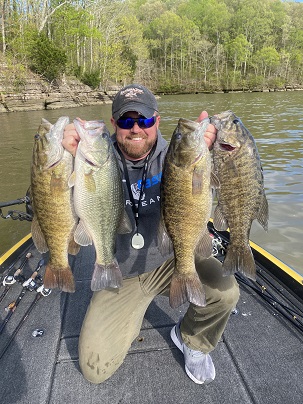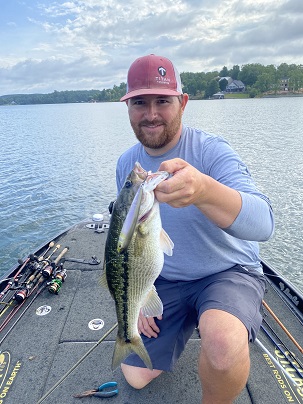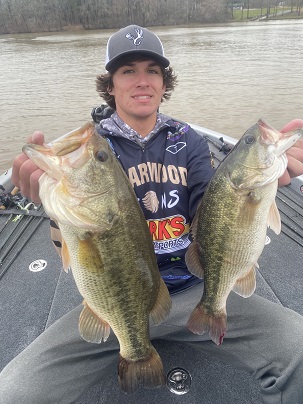
Pickwick largemouth, smallmouth and spots are mostly done spawning and are stacking up on shallow river ledges right now. They are feeding heavily, fattening back up from the stress of bedding. And they are shallow enough to be easy to catch.
Pickwick is a big TVA lake in the corner of Alabama, Tennessee and Mississippi on the Tennessee River. Like other lakes in the chain, its big flats and creeks are bass spawning factories and the river and creek ledges offer perfect feeding places year-round in the fertile waters.
Cody Harrison says he started fishing “as soon as I could cast.” Living in Tuscumbia, just 15 minutes from Pickwick, he fell in love with bass fishing very young and learning the ways of the fish in the lake. He went to the University of North Alabama where he was on the college team with many other good fishermen and honed his skills for two years. After graduation four years ago, he started guiding on Pickwick, Wilson and Guntersville full time.
“A few bass will still be spawning in May, but most are done and moving to summer holes on the main river,” Cody said. You can always catch some good fish shallow, but you can find the right ledge and catch fish after fish from big schools. And you will catch smallmouth and a few big spots, as well as quality largemouth, in the river.
A wide variety of baits will catch Pickwick bass in May, and you can fish your favorites. Cody has his, including a swim bait, crankbait, jig and pig, Carolina Rig and even a shaky head if fishing is tough. All baits are adjusted in weigh based on current and depth he is fishing.
We fished the following ten spots on April Fools Day, a cold, windy day with a strong river current that made fishing difficult. And many bass were already in spawning areas, but some were still out in the pre-spawn stage. They will be strong on this pattern now.
Cody still caught two smallmouth in the 3.5 to 4 pound range, a largemouth that size and a slightly smaller, very pretty meanmouth. Meanmouth are a smallmouth/spot hybrid that has the markings of a smallmouth but the tooth patch of a spot. They are fairly common in the lake and may be a bad sign for the future of smallmouth fishing here.
1. N 34 45.591 – W 87 51.269 – We put in at Cane Creek Ramp, a good location for fishing this area of the lake. Right at the cove the ramp is in, signs mark a pipeline crossing on that side, with matching signs across the river. Near the middle of the river a little more toward the North West bank, there is a “blow out” hole at the river edge where the pipeline goes across.
This hole is 18 to 20 feet deep on the edges, dropping into deeper water fast. It is covered in rocks and spots and smallmouth love rocks, and largemouth will use them for feeding ambush points too.
Sit on the upstream side of the pipeline off the lip of the drop. Cast your bait up current and work it back with is. Current here and on other places really help the bite if it is not too strong to fish.
Cody likes a True Bass 4.5 to 5.5 shad colored swimbait rigged on a one half to three quarters ounce jig head, depending on current. Let it go to the bottom then swim it along steadily with the current, just ticking the rocks. You will get hung doing this until you get the feel for the depth and speed to move you bait.
You can fish a Carolina rig or shaky head here, depending on current, but those get hung more often. If the current is slack bouncing a shaky head on the rocks may get bit but it is slow fishing.
2. N 34 44.940 – W 87 45.811 – Going up the river where it bends to the left, a series of long islands on your left separate the river from old oxbows. The main one is named Coffee Slough and is full of cypress trees, grass beds and stumps. It is a big bedding area and some fish live back in here year-round.
Idle in to the first big clump of cypress trees in the middle and start fishing. Be careful, there are many stumps to hit. Cody says you could stay in here and catch bass all day. Some will be feeding post spawn, some will be bedding and some may still be pre spawn depending on the weather.
Cody will bump stumps and cypress knees with a Strike King 1.5 or 2.5 squarebill, making them hit and dart off to the side. A black or white buzzbait with a clacker will also catch fish for Cody, as will a frog fished in the grass. If the fishing is tough, he will go with a weightless Trick worm worked slowly around all cover.
3. N 34 50.143 – W 87 56.189 – Back down the river at the Natchez Trace Parkway bridge, a long river ledge runs parallel to the bank upstream of the bridge near the left side going downstream. The ledge runs at a slight angle toward the bank going upstream. It is seven to eight feet deep on top but drops fast into 15 feet of water.
Keep your boat 15 feet deep and cast a crankbait, swim bait or jig up on the top of the ledge. Bump bottom to the lip and let your swimbait or jig fall down the drop. They will hold on the drop but move on top to feed, especially when current is washing along it.
Fish along the ledge, probing for any cover on it that provides a current break for the bass. When you catch a fish make repeated cast in that area since they will school up in specific spots along the ledge.
4. N 34 52.441 – W 87 56.571 – Going down the river, Jenkins Branch is the opening on your right before you get to Bluff Creek. It is narrow with steep rocky points on both sides, with pea gravel points downstream of it.
Cody says bass spawn in the branch then move to the points to feed. They will school on top here so have a Fluke or topwater plug ready to cast to them. Also drag a shaky head and jig on the pea gravel points going downstream, as well as the main downstream point of the creek. Bump the bottom with a crankbait, too, keeping your boat over about 12 feet deep and casting to the bank with all baits.
“Smallmouth spawn first, then largemouth,” Cody said. This is one of the first places they move out to, and you will catch both here as well as an occasional spot. Spots don’t grow as big or as fast here or on other lakes with them. A four pounder is a really big one.
5. N 34 52.632 – W 87 57.238 – The Bluff Creek channel runs way out across a flat to the river channel. If you look at your GPS or a good paper contour map, you will see two old channels that form a wishbone before coming together near the river. The lip of the creek channel where they hit the river is an excellent post spawn feeding spot.
Keep your boat in 23 feet of water and cast a crankbait, Carolina Rig and jig up on the lip of the channel in about 14 feet of water. Work them with the current, bumping bottom to the edge then dropping down the edge of it.
Cody says a good rate of flow for fishing it 20,000 to 70,000 cubic feet per second of water released at the dam. Lower and the fish don’t feed well. Higher and it is hard to fish. (it was about 90000 on April 1!) You can download an app at https://www.tva.com/Environment/Lake-Levels/TVA-Lake-Info-App to get this information.
6. N 34 53.601 – W 87 58.469 – Going down the river a hump rises to about 12 feet deep in the middle of the river out from the mouth of Long Branch. The old branch channel runs along the downstream side of it. You can line up on it by getting straight out from the small islands just upstream of the creek mouth.
The hump is a shell bed and Pickwick bass love feeding around shell beds. Sit in 18 feet of water and cast across the hump with swim bait, jig and shaky head and Carolina rig.
Wind can be a problem in big water like this. If blowing with the current it moves you too fast. If blowing against the current it makes bigger waves. In either direction, it can make casting and line control difficult. If possible, always sit downstream of these places and cast your bait upstream so it moves with the current in a natural action.
7. N 34 53.594 – W 87 59.340 – The Brush Creek channel runs over half way across the big flat on the right side to the river channel. The lip of it has stumps on it and bass hold and feed around them. It is a good place to fish but you will get hung.
Cody sits shallow here, in about 15 feet of water on top of the ledge and cast upstream to 20 feet deep. Work a swimbait, jig or shaky head here, trying to keep them moving just off the bottom to lessen hang-ups. A Carolina rig will catch fish but it gets hung a lot.
For the big smallmouth and largemouth in Pickwick, Cody rigs a green pumpkin or plumb Magnum Trick worm on a one half to three quarters ounce locally made Mean Mouth jig head. He dips the tails of his plastics in JJs Magic. Orange entices bites if he sees crawfish with orange on them, but chartreuse imitates bluegill that are always have fins fringed in that color.
8. N 34 54.225 – W 88 02.294 – Going downstream the river channel swings in near the left bank then out from it where the bank makes a turn to the left. A red channel marker sits on the upstream point of a sunken island named “Bee Tree Island” on my paper map. The point of the island cause a current break and it is about 15 feet deep on top.
Cody sits on top of the island point in 15 feet of water and fan casts upstream, covering all sides of the point. A swim jig, shaky head, Carolina rig and jig all work well here.
Cody rigs his Carolina rig with a one-ounce sinker to get to the bottom fast in current and keep it there, allowing him to cover more water with it. He ties a big hook about three feet above the sinker and uses a green pumpkin magic or green pumpkin blue full-size Zoom Brush Hog on it.
9. N 34 53.553 – W 88 04.762 – The second red marker past the one in hole 8 sits on the side of a long bar running parallel to the channel. It is the edge of another sunken island named “Waterloo Island” on my map. The outside edge of it drops straight off and is what you want to fish here.
Start at the marker with your boat in 30 feet of water and cast to the top of the old island in 10 to 12 feet of water. Drag a jig, Carolina Rig or Shaky
Head to the lip and let if fall. Cody does not give any of those bait extra action, he just slides them along.
Cody likes a three quarters ounce green pumpkin blue Mean Mouth jig tipped with a matching Rage Craw with the tips dipped in JJs Magic. Slide it along the bottom then let if fall several feet when it comes off the lip before reeling in for another cast.
10. N 34 54.083 – W 88 06.117 – Across the river and downstream, the channel makes a turn to the right. Beach Creek enters on the right in the turn and the channel runs out to the river channel. Cody said this is called the “Catfish Hole” but it holds bass.
The flat on the sides of the channel has grass here, and Cody says this is a great numbers hole. He says you can sit in 20 feet of water, cast your Carolina rig up to six feet of water on the channel edges and work it back down to 20 feet deep.
You can catch 100 fish here when it is right, but not necessarily the big ones you need on Pickwick in a tournament. You may also see fish schooling on top here so be ready to cast to them.
These places are good right now and will hold fish all summer. Give them a try.
Contact Cody for a trip to see first-hand how he catches Pickwick bass at Basswacker Guide Service https://basswhackerguideservice.com/ or call 901-490-0882.





